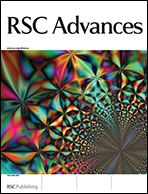A sea-cucumber-like hollow polyaniline spheres electrode-based chemical sensor for the efficient detection of aliphatic alcohols
Abstract
Sea-cucumber-like hollow polyaniline (PANI) spheres were synthesized by the chemical polymerization of aniline monomers in the presence of salicyclic acid. The synthesized sea-cucumber-like hollow PANI spheres were applied as a working electrode for the fabrication of highly sensitive, reliable and reproducible chemical sensors for detecting ethanol and other alcohols. The sea-cucumber-like hollow PANI spheres were extensively characterized in terms of their morphological, structural, optical, electrical and electrochemical properties. The morphological characterization revealed a sea-cucumber-like hollow morphology with a uniform decoration of nanofibrils covering the shell of the spheres. Cyclic voltammetry and electrochemical impedance spectroscopy (EIS) measurements were performed to elucidate the electrochemical behavior of sea-cucumber-like hollow PANI spheres electrode towards the detection of aliphatic alcohols. The sensing performances of the synthesized sea-cucumber-like hollow PANI spheres electrode towards the detection of alcohols were analyzed by the current (I)–voltage (V) characteristics. The sea-cucumber-like hollow PANI spheres electrode based ethanol chemical sensor showed considerably high sensitivity of ∼426.5 μA mM−1 cm−2 and a detection limit of ∼515.7 μM with a correlation coefficient (R) of ∼0.90157 and a short response time (10 s).


 Please wait while we load your content...
Please wait while we load your content...